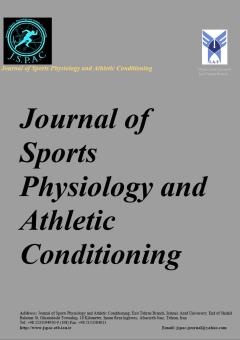Effects of Exercise-induced myokines on cardiac function: Muscle– cardiac Crosstalk in health and diseases
Subject Areas : Sport Physiology
1 - Assistant Professor, Department of Physical Education and Sport Sciences, Faculty of Command and Management, Imam Ali military' University, Tehran, Iran
Keywords: Exercise, myokines , cardiac function, Muscle, Crosstalk ,
Abstract :
Recent studies have shown that skeletal muscle serves as a secretory organ that can produce cytokines and other muscle fiber-derived peptides [1]. The contraction of skeletal muscle cells has been found to release humoral factors that regulate metabolic processes [2]. Cytokines and peptides released from skeletal muscle are generally classified as “myokines.” In general, myokines are muscle-derived molecules that perform physiological and pathological functions and maintain systemic homeostasis. Myokines regulate whole body metabolism in an autocrine, paracrine, or hormonal manner [3]. On the one hand, myofiber-induced myokines have positive autocrine and paracrine effects on satellite cell proliferation and muscle hypertrophy [4]. This can provide a feedback loop for the muscles to adapt to exercise training. On the other hand, myokines perform physiological functions by interacting with other distant non-muscular organs at the hormonal level and play an important role in mediating whole-body effects [5]. Emerging evidence suggests that myokines derived from skeletal muscle can improve human health and alleviate many diseases [6]. Numerous studies have shown that muscle mass and function are associated with cardiovascular disease risk [7]. Physical exercise improves cardiovascular health by releasing myokines, which promote the well-known protective effects and functions of the cardiovascular system. Myokines that affect cardiovascular health include dermcidin, follistatin-like 1 (FSTL1), myonectin, apelin, and musclin (Figure 1). Dermcidin secreted by ischemic skeletal muscle may be an important novel myokine that mediates muscle-cardiac cross talk and modulates cardiomyocyte survival and function by controlling cardiomyocyte apoptosis [8]. FSTL1 attenuates neointima formation in response to arterial injury by inhibiting muscle cell proliferation through an AMPK-dependent mechanism [9-11]. Furthermore, FSTL1 promotes endothelial cell function and stimulates revascularization in response to Akt-eNOS-induced ischemic signaling [12]. Abundantly expressed in skeletal muscle tissue, Myonectin is strongly induced in differentiated myotubes and expressed primarily in skeletal muscle. myonectin modulates the response to acute ischemic heart injury and protects the heart from ischemic reperfusion injury by inhibiting apoptosis and inflammatory responses in a mouse exercise model, thus mediating the beneficial effects of exercise on cardiovascular health [13]. Apelin binds to the APJ receptor and acts as an essential mediator of cardiovascular homeostasis and is involved in the pathophysiology of cardiovascular disease [14]. Hearts treated with Apelin show increased sensitivity to Ca2+, which may protect against hypertrophy and support cardiac function during the transition to heart failure [14]. In addition, the Apelin/APJ system attenuates cardiac hypertrophy induced by angiotensin II, oxidative stress and exercise [15]. In addition to apelin, muscle binds to natriuretic peptide clearance receptors and is involved in blood pressure regulation [16-19].

